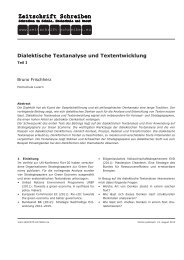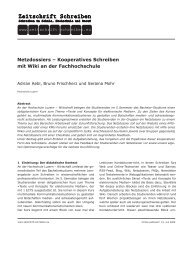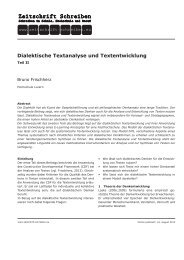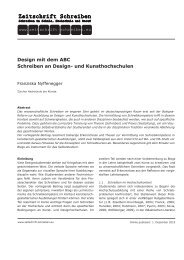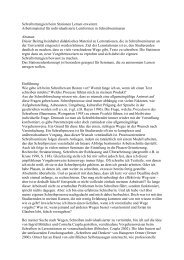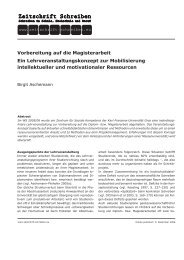Active Reading and the Teaching of Writing - Zeitschrift Schreiben
Active Reading and the Teaching of Writing - Zeitschrift Schreiben
Active Reading and the Teaching of Writing - Zeitschrift Schreiben
You also want an ePaper? Increase the reach of your titles
YUMPU automatically turns print PDFs into web optimized ePapers that Google loves.
comprehension.<br />
If students learn to recognize text structure, <strong>the</strong>y<br />
become more able to write texts that are well organized<br />
<strong>and</strong> with ideas hierarchically disposed in <strong>the</strong>m.<br />
The use <strong>of</strong> reading questions<br />
In <strong>the</strong> previous exercises we guided our student to<br />
recognize <strong>the</strong> structure <strong>of</strong> <strong>the</strong> texts <strong>the</strong>y study <strong>and</strong> to<br />
orient <strong>the</strong>ir reading activity towards specific purposes.<br />
Now we are going to propose some reading questions<br />
in order to show that <strong>the</strong> same text can be analyzed<br />
from different points <strong>of</strong> view, <strong>and</strong> so can be a source<br />
for different writing tasks in different disciplines.<br />
Some years ago, Filippo Boschi proposed a test, called<br />
«five ways <strong>of</strong> <strong>the</strong> mind» or 5WM (in Italian, «5VM», «5<br />
vie della mente»). This test is made by five different<br />
groups <strong>of</strong> reading questions. Every group <strong>of</strong> questions<br />
is related to a particular field <strong>of</strong> analysis: linguistic,<br />
inferential, logical, moral evaluation, aes<strong>the</strong>tic. 12 For<br />
every field <strong>of</strong> analysis <strong>the</strong>re is an exercise, composed<br />
by a brief text <strong>and</strong> some questions.<br />
In this way, students are always supposed to analyze<br />
<strong>the</strong> whole text <strong>and</strong> not only single words, also when,<br />
as it happens in <strong>the</strong> test on linguistic competence, <strong>the</strong>y<br />
are required to explain <strong>the</strong> meaning <strong>of</strong> a single word or<br />
a single phrase.<br />
This choice was made to mark <strong>the</strong> distinction between<br />
<strong>the</strong> capability to underst<strong>and</strong> words without context <strong>and</strong><br />
<strong>the</strong> capability to reflect upon <strong>the</strong> role <strong>of</strong> words in a<br />
text. 13<br />
With a test like <strong>the</strong> 5WM, teachers can provide effective<br />
support in order to solve particular problems <strong>of</strong> <strong>the</strong>ir<br />
students (<strong>and</strong> to enhance students’ attitude) in every<br />
field <strong>of</strong> analysis. 14 We can propose some hints to<br />
organize different activities for each field, as shown<br />
below. With <strong>the</strong> five fields <strong>of</strong> analysis described below,<br />
we want to show <strong>the</strong> importance <strong>of</strong> learning by doing.<br />
To solve <strong>the</strong> proposed exercises, students are required<br />
to collaborate with <strong>the</strong>ir colleagues <strong>and</strong> with <strong>the</strong><br />
teacher; <strong>the</strong>y will learn to use texts not only to take<br />
information, but also to acquire new skills, that <strong>the</strong>y<br />
will use to analyze o<strong>the</strong>r texts in o<strong>the</strong>r situations.<br />
Language Comprehension Skills<br />
With <strong>the</strong> expression «Language Comprehension Skills»<br />
we mean <strong>the</strong> capability to underst<strong>and</strong> <strong>the</strong> structure<br />
<strong>and</strong> meaning <strong>of</strong> sentences as well as <strong>the</strong> relationships<br />
among sentences. In this field, we can propose<br />
paraphrases exercises, in order to teach our students to<br />
restate, using <strong>the</strong>ir own words <strong>and</strong> <strong>the</strong>ir own sentence<br />
structures, single expressions, phrases <strong>and</strong> entire<br />
paragraphs. In this way, students are encouraged to<br />
note <strong>the</strong> difference between <strong>the</strong> general meaning <strong>of</strong><br />
a word (for example, <strong>the</strong> meaning <strong>the</strong>y can find using<br />
a dictionary) <strong>and</strong> <strong>the</strong> specific meaning a word can<br />
assume in a particular context. We can also propose<br />
different possible paraphrases <strong>of</strong> <strong>the</strong> same text <strong>and</strong> ask<br />
our student to choose <strong>the</strong> best one.<br />
Inferential Skills<br />
By this expression, we mean <strong>the</strong> ability to connect<br />
pieces <strong>of</strong> information within <strong>and</strong> across sentences,<br />
using knowledge <strong>of</strong> discourse <strong>and</strong> logical reasoning,<br />
<strong>and</strong> to draw appropriate text-based inferences. We<br />
can propose different kinds <strong>of</strong> exercises: first, we can<br />
guide our students to identify which elements <strong>of</strong> <strong>the</strong><br />
text can be connected. Then, we can guide <strong>the</strong>m to<br />
draw inferences. We can distinguish two categories <strong>of</strong><br />
inferences: text-based inferences that are based only<br />
on <strong>the</strong> text students are reading; <strong>and</strong> inferences that<br />
require students to use also <strong>the</strong>ir knowledge <strong>of</strong> <strong>the</strong><br />
world (social rules, biological laws <strong>and</strong> so on…). 15<br />
Logical abilities<br />
In this article, we focus our attention on reading texts.<br />
So we are not interested in logical abilities in general<br />
(for example, logical abilities in math), but in <strong>the</strong> role<br />
<strong>of</strong> logical abilities in text comprehension. So, we can<br />
propose to our students to analyze texts in order to<br />
detect significant quantification words <strong>and</strong> expressions<br />
(e. g. «everyone», «none», «some»…) <strong>and</strong> connectors<br />
(e. g. «<strong>and</strong>», «if…<strong>the</strong>n»…). Then, students are guided<br />
to underst<strong>and</strong> <strong>the</strong> role <strong>of</strong> quantification words <strong>and</strong><br />
connectors in texts.<br />
Moral evaluation skills<br />
By this expression, we mean <strong>the</strong> capability to analyze<br />
literary texts with particular attention to characters’<br />
psychological attitudes <strong>and</strong> behaviours. Students<br />
are progressively guided to reconstruct characters’<br />
behaviours, to evaluate <strong>the</strong>m <strong>and</strong> to find in <strong>the</strong> text<br />
significant reasons to confirm <strong>the</strong>ir <strong>the</strong>ory.<br />
Aes<strong>the</strong>tic judgment skills<br />
In his famous novel, The Picture <strong>of</strong> Dorian Gray, Oscar<br />
Wilde stated that «Books are well written, or badly<br />
written. That is all». In this field <strong>of</strong> text analysis we are<br />
obviously not going to make our students a group <strong>of</strong><br />
aes<strong>the</strong>tes, but we want to make <strong>the</strong>m more conscious<br />
about rhetorical elements <strong>and</strong> writing techniques. So,<br />
Marinella Lizza: «<strong>Active</strong> <strong>Reading</strong> <strong>and</strong> <strong>the</strong> <strong>Teaching</strong> <strong>of</strong> <strong>Writing</strong>» www.zeitschrift-schreiben.eu 10.10.2007 Seite: /8



